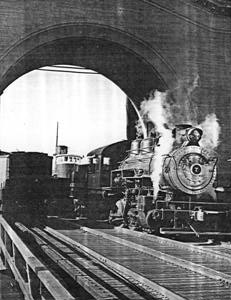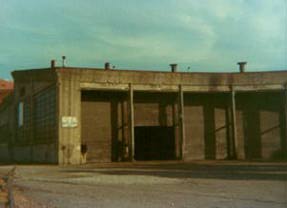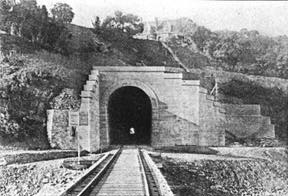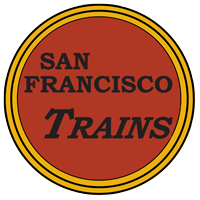
The State Belt Railroad of California was a shortline that served San Francisco’s waterfront, with its tracks extending the length of the Embarcadero from south of Market Street to Fort Mason and the Presidio. Although locals nicknamed the line the Toonerville Trolley and the Wooden Axle Line, the State Belt had an illustrious career.
The first trackage of the State Belt was built by the Board of State Harbor Commissioners in 1889. At that time, the lands along the waterfront were owned by the State, not San Francisco. These lands were once under water, so they were not included in the original survey of the City.
The original tracks were dual-gauged, to allow transfer of narrow gauge freight cars from the North Pacific Coast R.R. (Marin County) and the South Pacific Coast R.R. (Alameda, Santa Clara, Santa Cruz counties), as well as standard gauge cars. These first tracks did not yet connect to the outside world – all cars were ferried in from around the San Francisco Bay. Belt tracks finally connected with Southern Pacific tracks in 1913 at a small interchange yard located at Townsend and Berry Streets.

The State Belt built a five-stall concrete-reinforced roundhouse at Sansome and the Embarcadero. (This historic structure still stands today as an office building). This engine facility housed a modest number of oil-fired steam switchers (mostly 0-6-0’s), and later, ALCO S-2 diesels. The railroad also owned four freight cars – idler flatcars that were used to prevent the heavy engines from rolling onto the car ferries. Ferry slips were located near Fisherman’s Wharf. The railroad transferred cars from the Santa Fe, the Northwestern Pacific, and the Western Pacific.

Construction at the 1915 Panama-Pacific World’s Fair and traffic to Fort Mason justified the construction of a tunnel, 1500 feet long, 15 feet wide and 22 feet high underneath the Fort Mason Military Reservation. Eventually tracks were extended across what is now the Marina District to Crissy Field to serve the Presidio.
The Belt weathered the Great Depression by virtue of state ownership – it was operated more as a public utility than a for-profit business. A connection to the Santa Fe’s China Basin operations opened in 1933 with the construction of the 3rd Street Bridge (now the Lefty O’Doul Bridge) across Mission Creek. As the Board owned San Francisco’s whole waterfront, this crossing and all pier trackage coming off the joint Santa Fe-Southern Pacific line on Illinois Street (dubbed “District B” in later years) were part of the Belt, although they remained privately operated.
World War II generated a large amount of trans-Pacific traffic, and the State Belt contributed greatly to the movement of materials during the War. Army and Navy switchers were added to provide enough locomotive capacity. The State Belt also delivered trainloads of troops to debarkation points, and picked up hospital trains and returning troops. The railroad moved 156 troop trains and 265 hospital trains in 1945 alone.
Operations slowly wound down as shipping moved across the Bay to Oakland. In 1969, with the State wanting to get out of the port business, San Francisco voters approved a bond issue to buy the Port of San Francisco. The State Belt thus became the San Francisco Belt Railroad. The new City-owned Port quickly found out that the port business was drying up on this side of the Bay and offered in 1973 to sell the railroad to any operator for $1. After more than half a year, a 20-year contract to operate the railroad was signed with Kyle Railways. Total trackage had fallen from 67 miles in 1950 to 58 miles in 1973.
Customers along the Embarcadero had vanished entirely by the late Eighties, and that stretch of track would ultimately be ripped up in 1991. The only activity took place at Pier 96, a newly built container facility on the south bank of Islais Creek. ALCO S-2 #23 was chosen to serve the facility, complete with the new number 49 and a new paint job in 49er colors. Pier 96 failed to attract much container traffic, though, and the Belt shut down when the Port declined to renew Kyle’s contract in 1993.
The San Francisco Belt – or, what remained of it – sat idle through the remainder of the Nineties, but a rebirth of sorts began in 2000* when LB Railco leased the trackage for their “dirty dirt” contaminated soil removal operation; San Francisco’s rich industrial heritage has left it with an equally rich layer of nasty contaminated soil that now must be dealt with every time there’s any sort of construction project that involves excavation. The company subsequently branched out to serve various other customers at Pier 96 and (with the installation of the Illinois Street drawbridge) Pier 80 as well. Engines 49 (renumbered back to #23) and 25 were returned to service for the operation, and LB Railco rebranded itself as the San Francisco Bay Railroad in 2008. Thus, while it’s unlikely that freight trains will ever rumble across the Embarcadero again, the torch of the State Belt continues to be carried.
*The early timeline of LB Railco’s San Francisco operation is a bit of a mystery. Bill Kaufmann and an SF Gate article claim that the “dirty dirt” hauling contract dates back to 1992, a year before the Belt shut down. Surface Transportation Board documents suggest that LB Railco did not operate on Port trackage until early 2001, so it’s unclear if their operation used different trackage or was a truck operation prior to then.
Original text by Thomas Beutel, additions by Evan Josa
Annotated Bibliography and References
The following sources have good information about the State Belt Railroad.
- Arnold, Stanleigh. “The Embarcadero Limited” in The Western Railroader, vol. 15, no. 2, issue 146 (December 1951). Huntington Beach: The Pacific Coast Chapter, Railway and Locomotive Historical Society, 1951. ISSN: 0149-4996. This is an early history of the railroad. It includes a Steam Engine roster and photos of #1, #3, #10, and #20.
- Brady, Matthew. “A Railway of Our Own” in San Francisco Independent, February 9, 1993. San Francisco: San Francisco Independent, 1993. Article discusses closing of the San Francisco Belt Line R.R. on Jan. 29, 1993. Also presents brief history and a 1906 photo looking east from Vallejo Street.
- Dow, McMorris and Joseph A. Strapac. “A State Belt Pictorial” in The Western Railroader, vol. 51, no. 533 (February 1988). Huntington Beach: The Pacific Coast Chapter, Railway and Locomotive Historical Society, 1988. ISSN: 0149-4996. This is the best history of the railroad that we’ve found. It has many pictures and it also includes a table of locomotive statistics and builders numbers.
- Dwyer, J. J. et al. Biennial Report of the Board of State Harbor Commissioners for the Fiscal Years Commencing July 1, 1912 and Ending June 30, 1914. San Francisco: California State Printing Office, 1914. ISBN: unknown. Contains descriptions of construction and maintenance, financials, pictures of Fort Mason tunnel, picture of engine house, picture of locomotive #7, and complete 1914 map of system trackage from Fourth Street to Laguna Street.
- Kaufmann, William H. and Kaufmann, Michelle S., “The State Belt: San Francisco’s Waterfront Railroad.” Signature Press, 2013. ISBN: 1930013345. The premier resource for information about the State Belt and its successors. History, photographs, track diagrams, and more.
- Nickle, Charles and Barbara Nickle, “The San Francisco Belt Line RR.” in Model Railroader Magazine vol. 47, no. 6 (April 1980). Milwaukee: Kalmbach Publishing Company, 1980. ISSN: 0026-7341. Contains a general history of the railroad, along with pictures and a suggestion of how to build a model of the railroad.
- (Photographs of the State Belt Railroad). Sacramento: Photo Collection of the California State Railroad Museum, various dates. The museum has a collection of photographs of State Belt locomotives (nos. 1 (original), 1 (new), 6, 8, 9, 10, 11, 20, 21, 22, 23, 24, and 25). Some photographs also show various work scenes and maintenance of way cars.
- Williams, Vernon A., “LB Railco, Inc.—Lease and Operation Exemption—San Francisco Port Commission.” Surface Transportation Board Finance Docket No. 33985, Dec 2000. One of a scant few publicly-available documents that cover LB Railco and its initial lease of Port property.
